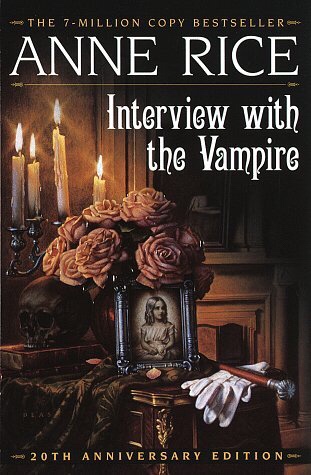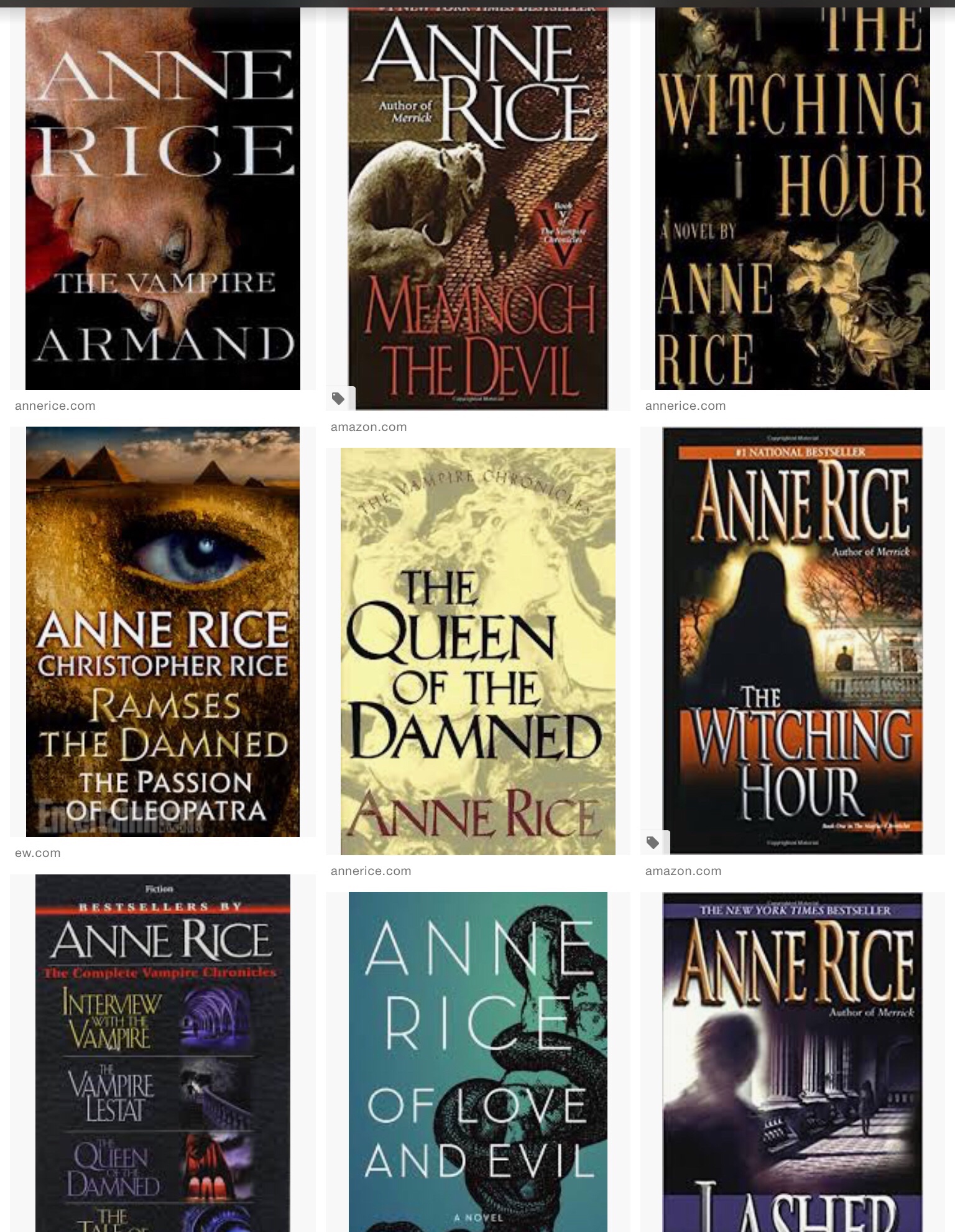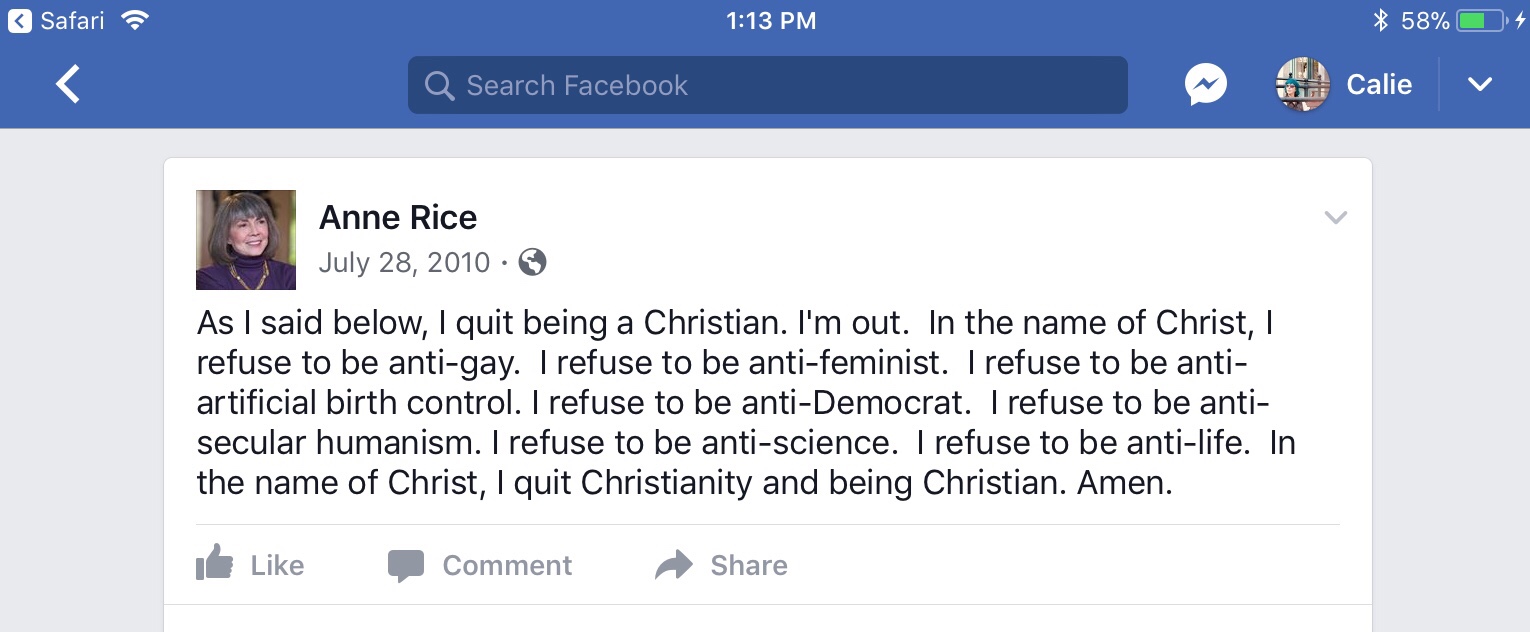
New Orleans-style Southern Gothic, where moisture blooms on your skin, where heat sits like a wet comforter on the trees, and the air smells of magnolia blossoms and rotting garbage. New Orleans, where the city dances, voodoo permeates, and vampires and witches prowl the street, along with their mortal prey. New Orleans.
I’ve never been.
But, because of Anne Rice (born Howard Rice, how’s that for a given name?), I feel as firmly about the existence of her New Orleans as I do about Rivendell. I’ve spent way too much time prowling the French Quarter with Lestat de Lioncourt or the gothic crumbling mansions with Rowan Mayfair.
Anne Rice sits firmly atop New Orleans in literature, Queen of the Damned indeed, in so many potential ways. She resurrected the vampire in the 80’s (and witches and mummies in the 90’s, and even Jesus in the early 2000’s) and led to the doomed-lovely-tortured-romantic-vampire-boys we love (or hate) today — Twilight, Buffy the Vampire Slayer, The Vampire Diaries, and True Blood. (She is also somewhat responsible for 50 Shades of Gray, although I highly prefer her Beauty series in terms of sheer hotness.)
With over 100 million copies of her books sold, and an estimated net worth of 60 million, Anne Rice reinvented dead stereotypes and infused them with modern sensibilities. She took the Byronic anti-hero and updated it to 80’s rock star. She put herself firmly on the horror map as the undisputed Queen of Horror in the 80’s and 90’s.

Her signature style is Southern Gothic, deriving from a rich literary tradition that has always had magical elements (see Faulkner, Bierce, O’Conner, and McCarthy, just as a small sample set). Gothic literature started in 1764 with the publication of The Castle of Otranto by Horace Walpole, although the term “gothic” strictly refers to a brief window of architectural style that flourished in Europe during the High and Middle Ages. Southern Gothic generally relies upon setting — decayed, crumbling, often isolated; stock characters (wicked fathers, brooding anti-heroes, fierce maidens), and elements of romanticism such as individuality, nature, emotion. Her prose is sultry with Southern heat, overwrought with embers of desire, and populated by bad boy archetypes of swooning desire.
Named “Howard” at birth (1941) after her father (she changed her name to Anne in first grade) her early life was punctuated by her mother’s alcoholism and the environs of New Orlean’s style Catholicism. She moved to Texas, then to California, married Stan Rice, and had a daughter Michelle who died of acute granulocytic leukemia (at age five) and a son Christopher (also an author). In her youth she labeled as agnostic, particularly while living in California, where she wrote Interview with a Vampire, which was published in 1976. The book became an underground cult classic.
After Interview, she wrote two historical novels (The Feast of All Saints and Cry to Heaven) along with her four Beauty erotic novels (under the pseudonym A.N. Roquelaure) and two more erotics under the pen name Anne Rampling (Exit to Eden and Belinda). She returned to the vampire genre in 1985 with The Vampire Lestat, then set her sights on witches and moved back to New Orleans in 1988 with The Witching Hour. She has since dealt with mummies, Atlantis, secret societies, and Jesus.

As far as my acquaintance with her goes, she is single-handedly responsible for my hippie goth phase in the late ’80s (I was always too much of a Boulder child to truly embrace black eyeliner) and an endearing love for floppy-haired, terminally brooding, angsty goth boys.
For Anne Rice, her Catholic upbringing has always been a part of her life and writing, whether she is embracing or denying the church. She has always been Louis, saying Interview was “Louis’s quest for meaning in a godless world.”
Her conversion occurred after health issues, when she famously returned to the arms of the Roman Catholic Church in 1998, although she failed to embrace the church’s positions on social issues, particularly being a supporter of full equality for gay men and lesbians, abortion rights, and birth control. In 2005, she stated her intention to use her life and talent of writing for God.
I stopped reading her at that point, for quite some time. As a lapsed Catholic myself, I did not understand how she could reconcile her love for the church with her love for her friends. In short, I was quite pissed at her, and also bored. By this point, for me, her writing had become almost a parody — and her books could always be found in the remaindered section of bookstores, should I have any desire. (Spoiler: I did go on to read all of her books, even as I despised myself for caving in and doing so, but the exercise was self-punishment and a study of morbid fascination, my own personal Catholic roots rearing snake heads.)
And then, in 2010, she unconverted, again, on her Facebook page stating, “Today I quit being a Christian…I remain committed to Christ as always but not to being ‘Christian’ or to being part of Christianity. It’s simply impossible for me to ‘belong’ to this quarrelsome, hostile, disputatious, and deservedly infamous group. For ten years, I’ve tried. I’ve failed. I’m an outsider. My conscience will allow nothing else.” (For more, check out this NPR interview.)

I have to admire her for that. It takes balls to officially break from the Catholic Church, as it evokes certain damnation of one’s soul, for strict theologians.
It’s hard for me, among others, not to see particularly her witches and vampires, as an expression of her personal argument with God. Certainly the vampire child Claudia reflects her intense antipathy, almost hatred, towards a being she believes is responsible for her daughter’s death. And as a product of Catholic school (again, I speak from personal experience), she seems to have adopted a bit of St. Augustine’s philosophies and course in life — from agnostic to conversion, from Louis the tortured vampire to Jesus. Unlike Augustine, she has carried the conversation further forward, and embraced her religious uncertainty.
In the end, it is perhaps a bit hard to separate Anne Rice from her characters, Catholicism, and New Orleans. She remains much as her beloved Lestat, the crown prince shaking his fist at God. She remains — Queen of the Damned.

She’s definitely a writer who is a force of nature. I really enjoyed her Vampire Chronicles in college, and can see how she’s made an indelible and impressive mark on the field.
I really enjoyed her Vampire Chronicles in college, and can see how she’s made an indelible and impressive mark on the field.
I’ve only ever read Interview with the Vampire. And I admit to sneaking peaks at the pages of her Beauty trilogy when I was 18 and working in a bookstore. That may not SOUND young, but I was very inexperienced and sheltered at the time.
I read parts of Exit to Eden when I was twelve because my parents never bothered to censor my reading material. I might have been an inexperienced, awkward, and unpopular teenager but I did know a shocking amount. They never put this in those “get kids to read” public service announcements.
I was absolutely obssessed with her books when I was in middle school. I have vivid memories of reading the Vampire Chronicle books after the kids I was babysitting went to sleep. The semi-scary books combined with their house’s sliding glass door made me paranoid that I was going to get murdered. Anne Rice’s books made me fall in love with New Orleans and I still have never been. Quite frankly, I know I’d be disappointed that it won’t be the New Orleans from her books. I have to give you credit for reading all of her books because even when I was twelve, I knew that some of them were definite misses.
I have never, ever read Anne Rice, although I’m not sure why that is and although I noted with interest her on-again, off-again relationship with the Catholic church. I was interested in the intersection of religion with writing, because the faith tradition I grew up with dictated that everything you create has to praise God. Literally. It’s a ridiculous dichotomy that Rice seems to have solved for herself by charting her own path.
I’ve known of other writers who’ve been kicked out of their traditions for writing what they do and who have had to find other churches (or not go at all). Charlaine Harris is one example, but she’s pretty happy in her new denom.
I didn’t know Charlaine Harris had similar issues. Interesting.